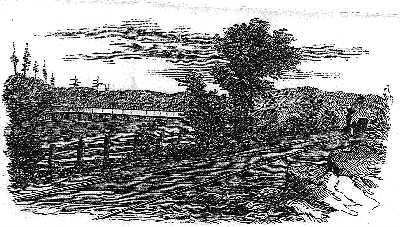|
The New Apalachin-Campville River Crossing replaces the bridge that was washed away in a flood in the late 1800s. by Emma M. Sedore, Town of Owego Historian |
 |
|
The New Apalachin-Campville River Crossing replaces the bridge that was washed away in a flood in the late 1800s. by Emma M. Sedore, Town of Owego Historian |
 |
Pearsall and Steele immediately formed a stock company with other Apalachin businessmen, and by the end of November 1849, a $7,500 wooden bridge was erected at the end of Pennsylvania Avenue. However, there was a catch. The railroad didn't keep their word about placing the station at the end of the bridge, but instead, built it two miles west, at Campville. Perhaps because Campville was exactly the midpoint (230 miles) between Dunkirk, New York on the eastern shore of Lake Erie, and New York City, it would be a perfect place for a stockyard. The Apalachin businessmen were provoked, but the bridge still saved a lot of time because the nearest crossings were at Owego and Broome County. (Sound familiar?)
Three years later, in the spring of 1852, a flood washed part of the bridge downstream. It was quickly repaired, but the following year another misfortune happened. While driving his team of horses, over the bridge, Ross McNeil of Campville broke through the wooden flooring and plunged into the river. He sued the stock company, and the matter was settled by awarding him the bridge. But, as fate would have it, another flood occurred a few years later sweeping the whole thing away, never to be rebuilt. The Apalachin men then constructed a large, flat-bottomed ferry which they used for their own accommodation to cross over to the Campville station.
It is doubtful that Pearsall and Steele sat in meetings repeatedly asking, "Should we? Where will it be? And who will pay for it?" Heck, if they could have seen our slow progress, they would probably ask, "What took you so long?"
Harper's NY & Erie Railroad Guide
Warren G. Olin, Past Tioga Co. Historian
Our County & Its People, LeRoy Kingman
Tioga County Historical Society Museum